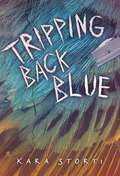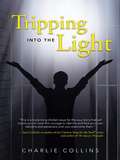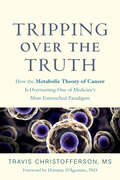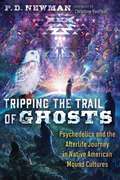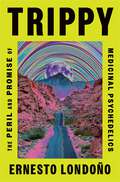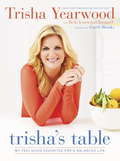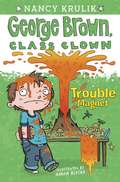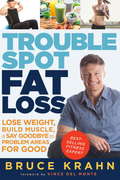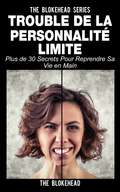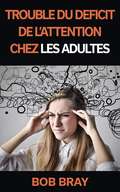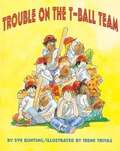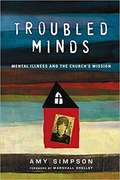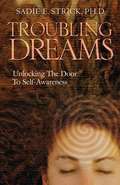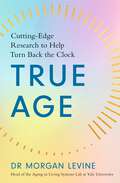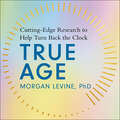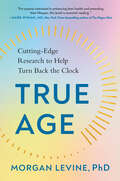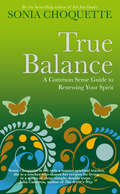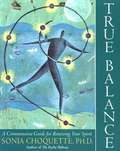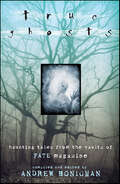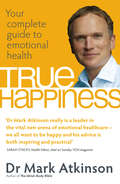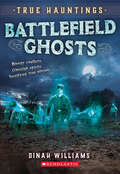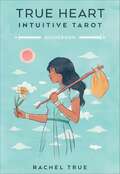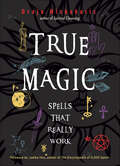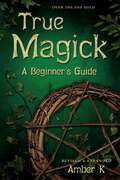- Table View
- List View
Tripping Back Blue
by Kara StortiFinn is a 17-year-old full of paradoxes. He's a drug dealer, but he's scoring money to send his twin sister to Harvard. He's desperate to shoot up even though he's the most popular kid in Dammertown. He's a philosopher and orator who's failing all his classes. The only time he finds peace is when he's bird-watching. Finn's life begins to spiral out of control, until he discovers a miracle drug called indigo. Finn is convinced that the drug is the way out of everything broken in his life. But is it really as magical as it seems?
Tripping Into the Light
by Charlie CollinsDiagnosed with a rare eye disorder in the third grade, Charlie's self-esteem began to unravel by the thread. He wouldn't have a future as a detective like his hero, Magnum P. I. He would never soar in a jet fighter like he dreamed. He would never drive a race car and see the checkered flag wave. College was out of the question, because he just wasn't smart enough. At least that's what the teachers told him. Only a God who was unusually cruel would shatter the dreams of a little boy by creating him defective. It was the only explanation that made any sense, and it was a crushing blow. If God didn't care about him, why should he care about himself? And so began Charlie's freefall into a world of negative self-talk and ultimately addiction. A self-destructive plummet that would see him cheat death twice as he marched to the precipice of suicide. Raw and brutally honest, Tripping into the Light is a tale of soaring triumphs and heartbreaking defeat. It illustrates the power of true love and the undying spirit of hope. It is about one man's willingness to try just one more time, when it seemed all was lost. Through Charlie's eyes, we see that all things are possible if we are willing to roll up our sleeves and do the work. www. TrippingIntoTheLight. com
Tripping over the Truth: How the Metabolic Theory of Cancer Is Overturning One of Medicine's Most Entrenched Paradigms
by Travis ChristoffersonA masterful synchronization of history and cutting-edge science shines new light on humanity&’s darkest diagnosis.Over 50,000 copies sold! &“Tripping over the Truth will have profound consequences for how cancer is managed and prevented.&”—Thomas N. Seyfried, author of Cancer as a Metabolic DiseaseIn the wake of the Cancer Genome Atlas project&’s failure to provide a legible roadmap to a cure for cancer, science writer Travis Christofferson illuminates a promising blend of old and new perspectives on the disease. Tripping over the Truth follows the story of cancer&’s proposed metabolic origin from the vaunted halls of the German scientific golden age to modern laboratories around the world. The reader is taken on a journey through time and science that results in an unlikely connecting of the dots with profound therapeutic implications.Transporting us on a rich narrative of humanity&’s struggle to understand the cellular events that conspire to form malignancy, Tripping over the Truth reads like a detective novel, full of twists and cover-ups, blind-alleys and striking moments of discovery by men and women with uncommon vision, grit, and fortitude. Ultimately, Christofferson arrives at a conclusion that challenges everything we thought we knew about the disease, suggesting the reason for the failed war against cancer stems from a flawed paradigm that categorizes cancer as an exclusively genetic disease.For anyone affected by this terrifying disease and the physicians who struggle to treat it, this book provides a fresh and hopeful perspective. It explores the new and exciting non-toxic therapies born from the emerging metabolic theory of cancer. These therapies may one day prove to be a turning point in the struggle against our ancient enemy. We are shown how the metabolic theory redraws the battle map, directing researchers to approach cancer treatment from a different angle, framing it more like a gentle rehabilitation rather than all-out combat. In a sharp departure from the current &“targeted&” revolution occurring in cancer pharmaceuticals, the metabolic therapies highlighted have one striking feature that sets them apart—the potential to treat all types of cancer because they exploit the one weakness that is common to every cancer cell: dysfunctional metabolism.With a foreword by Dr. Dominic D&’Agostino, PhD and contributions from Thomas Seyfried, PhD, author of Cancer as a Metabolic Disease; Miriam Kalamian, EdM, MS, CNS, author of Keto for Cancer; and Beth Zupec Kania, consultant nutritionist of The Charlie Foundation.&“Brilliant, timely, and expertly consolidated . . . It reads like a novel and is easy to comprehend for everyone interested in the new conversation around cancer and cancer care. I recommend it to patients, family, friends, and colleagues and refer back to it often.&”—Dr. Nasha Winters, ND, coauthor of The Metabolic Approach to Cancer
Tripping the Trail of Ghosts: Psychedelics and the Afterlife Journey in Native American Mound Cultures
by P. D. Newman• Examines the Path of Souls or Trail of Ghosts, a Native American model for the after-death journey• Demonstrates how psychoactive plants were used to evoke the liminal state between life and death in initiatory rites and spirit journeys• Explores the symbology of the large earthwork mounds erected by the Indigenous people of the Mississippi Valley and how they connect to the Path of SoulsThe use of hallucinogenic substances like peyote and desert tobacco has long played a significant role in the spiritual practices and traditions of Native Americans. While the majority of those practices are well documented, the relationship between entheogens and Native Americans of the Southeast has gone largely unexplored.Examining the role of psychoactive plants in afterlife traditions, sacred rituals, and spirit journeying by shamans of the Mississippian mound cultures, P. D. Newman explores in depth the Native American death journey known as the "Trail of Ghosts" or "Path of Souls." He demonstrates how practices such as fasting and trancework when used with psychedelic plants like jimsonweed, black nightshade, morning glory, and amanita and psilocybin mushrooms could evoke the liminal state between life and death in initiatory rites and spirit journeys for shamans and chiefs. He explores the earthwork and platform mounds built by Indigenous cultures of the Mississippi Valley, showing how they quite likely served as early models for the Path of Souls. He also explores similarities between the Ghost Trail afterlife journey and the well-known Egyptian and Tibetan Books of the Dead.
Trippy: The Peril and Promise of Medicinal Psychedelics
by Ernesto LondoñoA riveting look at the tremendous promise and inherent risks of the use of psychedelics in mental health treatment through the lens of a New York Times reporter whose journalistic exploration of this emerging field began with a personal crisis.When he signed up for a psychedelic retreat run by a mysterious Argentine woman deep in Brazil’s rainforest in early 2018, Ernesto Londoño, a veteran New York Times journalist, was so depressed he had come close to jumping off his terrace weeks earlier. His nine-day visit to Spirit Vine Ayahuasca Retreat Center included four nighttime ceremonies during which participants imbibed a vomit-inducing plant-based brew that contained DMT, a powerful mind-altering compound.The ayahuasca trips provided Londoño an instant reprieve from his depression and became the genesis of a personal transformation that anchors this sweeping journalistic exploration of the booming field of medicinal psychedelics. Londoño introduces readers to a dazzling array of psychedelic enthusiasts who are upending our understanding of trauma and healing. They include Indigenous elders who regard psychedelics as portals to the spirit world; religious leaders who use mind-bending substances as sacraments; war veterans suffering from PTSD who credit psychedelics with changing their lives; and clinicians trying to resurrect a promising field of medicine hastily abandoned in the 1970s as the United States declared a War on Drugs.Londoño’s riveting personal narrative pulls the reader through a deeply researched and brilliantly reported account of a game-changing industry on the rise. Trippy is the definitive book on psychedelics and mental health today, and Londoño’s in-depth and nuanced look at this shifting landscape will be pivotal in guiding policymakers and readers as they make sense of the perils, limitations, and promises of turning to psychedelics in the pursuit of healing.
Trisha's Table
by Trisha Yearwood Beth Yearwood Bernard Garth BrooksCountry music superstar, Food Network standout, and bestselling cookbook author Trisha Yearwood shows how delicious foods and wholesome dishes are part of the same balanced lifestyle. Trisha Yearwood is as much a force in the kitchen as she is on stage. But after years of enjoying decadent Southern comfort food, her culinary philosophy is evolving. As Trisha says, "I have adopted an 80/20 rule: 80 percent of the time I make good choices; 20 percent of the time I let myself splurge a little." Whether surprisingly virtuous or just a little bit sinful, the recipes in Trisha's Table all bring that unmistakable authenticity you've come to love from Trisha. You'll find brand-new dishes emblematic of the variety and balance Trisha champions. They skimp on anything but flavor, including dairy-free Angel Hair Pasta with Avocado Pesto, low-calorie Billie's Houdini Chicken Salad, vegetarian Smashed Sweet Pea Burgers, and tasty, high-protein Edamame Parmesan, alongside too-good-to-give-up family favorites, such as Slow Cooker Georgia Pulled-Pork Barbecue, Chicken Tortilla Casserole, Snappy Pear-Cranberry Crumble, and Chocolate Chip Cookie Dough Balls. Trisha wants to feed her loved ones--and yours, too--food that tastes good and food that's good for you. So pull up a seat at Trisha's Table and dig in!
Trouble Magnet (George Brown, Class Clown Book #2)
by Nancy KrulikGeorge Brown, Class Clown How much trouble can a burp get you into? A lot, if the burp is a magic one that makes you do wild and crazy stuff. George Brown is still trying his hardest to stay out of trouble at his new school. But his magic burps keep landing him in mega-trouble, like when George and his new pal Alex build a volcano for their school project. Or even worse, when George joins a band and performs in the school's talent show. Seems like no matter what he does, this kid's a trouble magnet!
Trouble Spot Fat Loss
by Bruce KrahnFrom health and fitness expert, and author of The Fat-Fighter Diet, comes a guide to dropping the fat from your most stubborn, hard-to-lose "trouble" spots. We are obsessed with fat. But how much do you really know about it? In Trouble Spot Fat Loss, Bruce Krahn tackles fat-loss myths, explains what fat is, how it works, and how to drop fat from trouble areas in a healthy and sustainable way. This book combines diet and fitness in an accessible manner, without being restrictive or damaging to the body as so many modern fad diets are. Trouble Spot Fat Loss tells you where to start and how to stay motivated to achieve the healthy body you've always wanted. Contributing a foreword to the book is Vince DelMonte, the world-renowned "Skinny Guy Saviour," who developed the No-Nonsense Muscle Building program to help people live healthier, happier lives with a more satisfying body. His program has sold tens of thousands of copies across the world. Trouble Spot Fat Loss shows you how to reshape your body in a healthy way and keep fat off those trouble spots for good.
Trouble de la personnalité limite: plus de 30 secrets pour reprendre sa vie en main
by The BlokeheadGénéralement, le trouble de la personnalité limite est défini comme étant un trouble de santé mentale qui pousse les gens à éprouver des sentiments tumultueux qui se traduisent par des actions tumultueuses. La plupart du temps, ces sentiments et ces actions apparaissent sur une période de temps prolongée. Par conséquent, un diagnostic de trouble de la personnalité limite ne peut être effectué que si un individu a manifesté ces caractéristiques sur une période de plusieurs mois à plusieurs années. En outre, la plupart des spécialistes en matière de santé mentale évite de poser un diagnostic durant l'enfance et l'adolescence car l'esprit d'un enfant ou d'un adolescent fonctionne différemment par rapport à celui d'un adulte. Il est généralement admis qu'il est important d'attendre jusqu'à ce qu'une personne ait atteint l'âge adulte, ce qui permet au cerveau de se développer pleinement avant qu'un diagnostic ne puissent être posé avec une quelconque certitude. Il s'agit d'un consensus qui permet aux spécialistes de la santé mentale de travailler de manière prudente. Toutefois, cela a parfois des effets plutôt néfastes pour les personnes souffrant de ce trouble, car les personnes ayant manifestés ces caractéristiques plus tôt dans leur vie sont souvent obligées soit de continuer à vivre sans traitement, soit d'être traitées pour quelque chose dont elles ne souffrent pas jusqu'à ce qu'elles obtiennent enfin un diagnostic définitif. Il est donc d'autant plus difficile pour une personne qui est finalement diagnostiquée d'un TPL de recevoir le traitement approprié ou un traitement efficace.
Trouble du déficit de l'attention chez les adultes
by Bob Bray Bruno LavalY a-t-un lien entre le Trouble du Déficit de l'attention, le Trouble du stress Post Traumatique, et l'addiction? Si vous êtes conscient que vous présentez l'une des ses conditions, vous devrez découvrir que quelque chose de plus profond est entrain de se produire à l'intérieur de vous. Découvrez le. Obtenez ce livre tout de suite! Dans la version du livre définitif sur le Trouble du Déficit de l'Attention et Trouble d'Hyperactivité du Déficit de l'attention, vous apprendrez: · La définition et les symptômes du TDA et certaines raisons communes qu'il est mal diagnostiqué · De fausses idées au sujet du TDA, y compris que celle-ci touche uniquement les enfants · Certaines des causes possibles du TDA, aussi bien que les conséquences physiques, émotionnelles, et sociales de cette condition · Les tendances envers l'automédication parmi ceux souffrant de TDA, · Comment nous pouvons utiliser le sexe, le jeu, où même des conflits avec d'autres personnes afin de stimuler les substances naturelles comme l'adrénaline où la dopamine pour l'altération du cerveau · Les sept différents types du TDA · Comment la dépression et l'anxiété, produite par les traumatismes de l'enfance, lié au TSPT. · Pourquoi ceux souffrant du TDA et les toxicomanes sont attirés les uns par les autres · Comment mieux comprendre les signes de rechute et ce qui peut être fait à ce sujet · Quelques stratégies pratiques pour changer votre vie. Il ne s'agit d'un manuel exhaustif au sujet du TDA. C'est vrai que la perspicacité et la vision de l'auteur est dessiné à travers la programmation Neurolinguistique (PNL). Mais il n'enseigne pas seulement des faits, des statistiques, de
Trouble on the T-Ball Team
by Eve BuntingLinda feels left out as the only one on her first-grade T-ball team who hasn't “lost one.”
Troubled Minds: Mental Illness And The Church's Mission
by Marshall Shelley Amy SimpsonMental illness is the sort of thing we don't like to talk about. It doesn't reduce nicely to simple solutions and happy outcomes. So instead, too often we reduce people who are mentally ill to caricatures and ghosts, and simply pretend they don't exist. They do exist, however―statistics suggest that one in four people suffer from some kind of mental illness. And then there's their friends and family members, who bear their own scars and anxious thoughts, and who see no safe place to talk about the impact of mental illness on their lives and their loved ones. Many of these people are sitting in churches week after week, suffering in stigmatized silence. In Troubled Minds Amy Simpson, whose family knows the trauma and bewilderment of mental illness, reminds us that people with mental illness are our neighbors and our brothers and sisters in Christ, and she shows us the path to loving them well and becoming a church that loves God with whole hearts and whole souls, with the strength we have and with minds that are whole as well as minds that are troubled.
Troubling Dreams
by Sadie E. StrickA dream that terrifies is the internal gauge that should inform the dreamer serious problems exist. However, this kind of dream can serve as a teacher/guide, revealing to the dreamer anxiety filled areas in the dreamer's life and pointing the way to solutions through the use of symbols. Symbols are the "words" and the action in the dream is the clue or the "push" toward addressing the trouble spots. Dr. Strick, reveals that through the use of dreams and their content, it is possible to access the unconscious for enlightenment and guidance. She reveals how working through one's distressing dreams can lead to taking action and create a more fulfilling future.Troubling Dreams: Unlocking the Door to Self-Awareness explores, through eight true life stories, how to unlock the hidden meaning of troubling dreams, documents the journey from powerlessness to healing and shows how to achieve personal empowerment through the power of dream interpretation. Working through dreams alleviates depression, resolves anxiety, improves self-esteem so the dreamer can gain personal empowerment.
True Age: Cutting Edge Research to Help Turn Back the Clock
by Dr Morgan Elyse LevineResearch suggests that only 10-30% of our lifespan is determined by our genetics. This means that the vast majority of how we age is directly related to choices we make everyday - how and what we eat, exercise and sleep quality, to name a few. So, while ageing itself may be inevitable, what if there were a way to measure our biological age? And what if there were strategies to slow down, or even reverse, the ageing process?In True Age, Dr Morgan Levine gives us an insight into the cutting-edge developments in the science of aging and longevity and teaches us that through understanding our biological age, we can monitor and even control the process of ageing.True Age explores:- The concept of biological age and the methods now available to determine your own.- Types of foods likely to decrease our biological age - and which will age you prematurely.- What types of exercise are most effective for turning back the clock.- How much sleep we need and what other lifestyle patterns are most likely to help slow and reverse ageing.True Age will equip you with the tools you need to develop personal regimes, diets and routines specifically tailored to keep you looking - and feeling - as young as possible. Using her years of expert research in the field, Dr Levine will put you on the path to living a healthier and more proactive life.
True Age: Cutting Edge Research to Help Turn Back the Clock
by Dr Morgan Elyse LevineThe definitive guide to you and your age, showing you how to live your best life healthy and happy.Research suggests that only 10-30% of our lifespan is determined by our genetics. This means that the vast majority of how we age is directly related to choices we make everyday - how and what we eat, exercise and sleep quality, to name a few. So, while ageing itself may be inevitable, what if there were a way to measure our biological age? And what if there were strategies to slow down, or even reverse, the ageing process?In True Age, Dr Morgan Levine gives us an insight into the cutting-edge developments in the science of aging and longevity and teaches us that through understanding our biological age, we can monitor and even control the process of ageing.True Age explores:- The concept of biological age and the methods now available to determine your own.- Types of foods likely to decrease our biological age - and which will age you prematurely.- What types of exercise are most effective for turning back the clock.- How much sleep we need and what other lifestyle patterns are most likely to help slow and reverse ageing.True Age will equip you with the tools you need to develop personal regimes, diets and routines specifically tailored to keep you looking - and feeling - as young as possible. Using her years of expert research in the field, Dr Levine will put you on the path to living a healthier and more proactive life.(P) 2022 Penguin Audio
True Age: Cutting-Edge Research to Help Turn Back the Clock
by Morgan Levine, PhDCutting-edge research shows how to determine and decrease your true biological age.What if there was a way to measure our biological age? And what if there were strategies to slow down—or even reverse—the aging process? The answers to these questions lie at the heart of the groundbreaking work Dr. Morgan Levine is doing in her lab at Yale. True Age introduces readers to the latest developments in the science of aging and longevity. It provides an in-depth understanding of biological age and the methods now available to estimate our own. It helps us target an individualized plan to eat, exercise, and sleep, as well as pointing to other lifestyle practices like intermittent fasting and caloric restriction that have been shown to slow or reverse the aging process. The goal is to guide every reader toward a personal regimen to keep them as youthful as possible—both inside and out—with low risk, data-driven biohacking. The book gives readers and their doctors unprecedented ways to identify their personalized aging process and increase not only their lifespan but also then their healthspan.
True Balance: A Common Sense Guide to Renewing Your Spirit
by Sonia ChoquetteHow can we balance our time and energy when our days are so hectic? How can we find harmony in mind, body and spirit? In True Balance, renowned intuitive and spiritual healer Sonia Choquette presents a step-by-step workbook for finding balance within our seven essential energy centres, or chakras. Drawing upon her deep personal experience and practice, she offers a wise and down-to-earth guide to achieving harmony. With supportive questionnaires, practical advice and many specific remedies, Sonia leads us to a balanced life with creativity and blessings.
True Balance: A Commonsense Guide for Renewing Your Spirit
by Sonia Choquette"When you balance your seven energy centers, you reclaim your natural rights and reestablish your natural order. You begin to undo the damage that was caused by living your life backward, from the head first, forgetting the body and spirit altogether. As with everything in nature, if your life isn't supported by a grounded source of energy, it will wither and lose its vitality. As you learn about the chakras, you will discover that balancing them isn't particularly hard, especially if you think of it as a process of not just living your life, but actually loving your life. " -- From the Introduction How can we balance our time and energy when our days are so hectic? How can we find harmony in mind, body, and spirit? In True Balance, renowned intuitive and spiritual healer Sonia Choquette presents a step-by-step workbook for finding balance within our seven essential energy centers, or chakras. Drawing upon her deep personal experience and practice, she offers a wise and down-to-earth guide to achieving harmony. With supportive questionnaires, practical advice, and many specific remedies, Choquette leads us to a balanced life filled with creativity and blessings.
True Ghosts: Haunting Tales from the Vaults of FATE Magazine
by Andrew HonigmanFrom the vaults of FATE Magazine come true stories of encounters with ghosts, phantoms, and haunted places. An elderly waitress silently serves breakfast to two friends at an eerily deserted diner—and the next day, the friends discover the diner is out of business and slated for demolition. A phantom train still blows its whistle more than fifty years after a gruesome accident. And a grandfather's spirit brings a warning that saves his family from a deadly house fire.Over the past sixty years, FATE magazine has published thousands of true ghost stories—personal accounts from ordinary people who have had extraordinary run-ins with the spirit world. This collection features the best of these spine-tingling, bizarre, heartwarming, and sometimes humorous haunting experiences. These frightening firsthand reports include tales of:Ghostly ApparitionsMessages from the DeadDream VisitationsNear-Death and Out-of-Body ExperiencesHaunted PlacesSpirits Helping the LivingVortexes, Time Slips, and Portals to Other DimensionsSpirit Guides and Angels
True Happiness: Your complete guide to emotional health
by Dr Mark AtkinsonAre you fed up with the way you feel? Are fear, anger, low self-acceptance or other negative emotions holding you back from living the life you want? If, like so many others, you are unable to recognise what you really feel or want, this book will be invaluable. In THE MOOD DOCTOR'S GUIDE TO HAPPINESS, Dr Mark Atkinson will show you how to transform your mind and mood in order to realise your fullest potential for happiness. Packed with questionnaires, practical advice and exercises, this groundbreaking book will help you identify and release emotional baggage; change self-limiting beliefs and increase confidence; deepen your relationships and so much more. Ultimately it will help you discover your true self, that aspect that holds your unique talents and gifts and the one that can help you live a deeply fulfilling and happy life.
True Happiness: Your complete guide to emotional health
by Mark AtkinsonAre you fed up with the way you feel? Are fear, anger, low self-acceptance or other negative emotions holding you back from living the life you want? If, like so many others, you are unable to recognise what you really feel or want, this book will be invaluable. In THE MOOD DOCTOR'S GUIDE TO HAPPINESS, Dr Mark Atkinson will show you how to transform your mind and mood in order to realise your fullest potential for happiness. Packed with questionnaires, practical advice and exercises, this groundbreaking book will help you identify and release emotional baggage; change self-limiting beliefs and increase confidence; deepen your relationships and so much more. Ultimately it will help you discover your true self, that aspect that holds your unique talents and gifts and the one that can help you live a deeply fulfilling and happy life.
True Hauntings #2: Battlefield Ghosts
by Dinah WilliamsChilling tales of vicious battle . . . and vengeful spirits.A bloody soldier who disappears into thin air. Flickering orbs floating over a military cemetery.History is filled with brave fighters cut down in the heat of battle. But what if they aren't resting in peace?True Hauntings: Battlefield Ghosts revisits deadly clashes from the past and the ghosts they left behind, from a headless horseman galloping through the night to restless spirits rising from sunken ships, searching for revenge.In this second volume of haunted history, find out how true stories can be some of the most terrifying of all.
True Heart Intuitive Tarot
by Rachel TrueRachel True—beloved for her role in the cult classic movie The Craft—shares her tarot knowledge, gained through a lifetime of practice. Accessible and conversational, this guidebook, which is compatible with any tarot deck, helps readers use the cards as True does: with an intuitive approach. She shares personal stories from her experiences in Hollywood to illuminate how to personalize the meaning of each card, and how—much in the way Carl Jung used them in his practice—tarot offers wisdom based on the reader&’s present energy.Download the True Heart Intuitive Tarot ebook for tarot readings on the go, or for use with your own deck. The ebook includes the full guidebook, complete with art, but does not include the physical tarot deck.&“That's the beauty of tarot; you don't need any special talents. Just your open mind. You can pick up your own deck, clear your energy, and feel empowered doing it. The only thing you'll be summoning is your own intuition, insight, and connection to spirit.&”—Rachel True, from True Heart Intuitive Tarot
True Magic: Spells That Really Work
by Draja MickaharicWritten by renowned master of witchcraft Draja Mickaharic, author of Spiritual Cleansing, this book provides an introduction to natural magic as well as a practical reference for simple, everyday spells that really work. Included is an eclectic collection of over 100 spells, including water spells, spoken spells, spells passed down over generations, and spells developed by the author himself. Learn how to cast spells with water, incense, oils, and common kitchen herbs and with spoken and written words. Included are recipes and instructions on how to: •Cast protection spells for reversal spells that may be cast on you•Make baths for spiritual cleansing, growth, beauty, and harmony•Cast spells for beginning and ending relationships
True Magick: A Beginner's Guide
by Amber KFor fifteen years, Amber K's "little green book" has guided thousands down the life-changing path of magick. Selling more than 200,000 copies, True Magick has truly struck a chord with Witches, Pagans, and magicians around the world.Presented here for the first time is the revised and expanded anniversary edition of True Magick. It features the same delightful introduction to the history and lore of magick, in addition to several varieties of magick, ranging from shamanism and Norse Magick to Voudun and Qabala. Amber K explains the basics, such as how to find or create ritual tools, establish a temple, plan a ritual, and cast spells safely and ethically. New material includes six more chapters, recommending reading for each chapter, and more than 100 added exercises.
